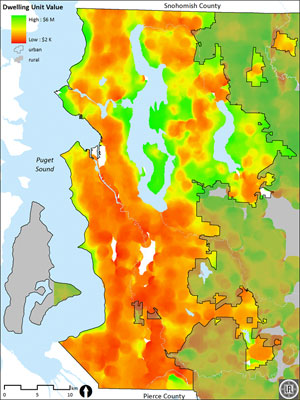Researchers at the University of Washington School of Public Health have found a strong association between home values and obesity among women in Seattle and its suburbs. The study is believed to the first of its kind in the U.S. to link obesity to assessed property levels at the individual level.
 "We knew that obesity affected some neighborhoods much more than others," said co-author Dr. Adam Drewnowski, professor of epidemiology and director of the Center for Public Health Nutrition. "But we did not expect to see geographic disparities on such a massive scale, especially in one of the healthiest counties in Washington State."
"We knew that obesity affected some neighborhoods much more than others," said co-author Dr. Adam Drewnowski, professor of epidemiology and director of the Center for Public Health Nutrition. "But we did not expect to see geographic disparities on such a massive scale, especially in one of the healthiest counties in Washington State."
The study found that women living in homes in the lowest 25 percent of assessed property values in King County were 3.4 times more likely to be obese than women living in top-end homes. The link held after adjusting for individual education and incomes. Property values were not associated with obesity among men. "People still talk about obesity rates by state, county or metropolitan area," Drewnowski said. "We wanted to take a closer look at the built environment, and the most granular data are at the individual tax parcel lot."
 Researchers conducted a telephone survey in 2008-2009 of a random sample of 2,001 adults of Seattle and its suburbs. Telephone numbers were matched with street addresses that were confirmed by respondents and geocoded. Property values came from county property tax records. Homes could be single-family homes or apartments, either rented or owned. The measure of property values also included the mean value of all properties within a 10-minute walk. Residents were asked their height, weight, age, gender, education and household income.
Researchers conducted a telephone survey in 2008-2009 of a random sample of 2,001 adults of Seattle and its suburbs. Telephone numbers were matched with street addresses that were confirmed by respondents and geocoded. Property values came from county property tax records. Homes could be single-family homes or apartments, either rented or owned. The measure of property values also included the mean value of all properties within a 10-minute walk. Residents were asked their height, weight, age, gender, education and household income.
Residential property values are a good measure of neighborhood wealth and are likely to reflect socioeconomic status better than either education or incomes. "Parks, trails, walkable neighborhoods, and access to healthy foods stores are what make a neighborhood desirable – and more expensive," said Drewnowski. "Unfortunately, obesity thrives in lower-income areas. Understanding social disparities will help us understand what drives the obesity epidemic."
The study was published in the journal Social Science & Medicine. Lead author was Colin Rehm, a doctoral student in the School of Public Health's Department of Epidemiology. The study was conducted jointly with the Urban Forum Lab at the UW College of Built Environments and was funded by the National Institutes of Health.
